When looking for case law, your first thought might be to go to our U.S. Supreme Court Library or Fastcase databases. Those are great resources, but have you ever thought about checking out the Law Journal Library and Bar Journals Library? In these collections, you can find analysis, background, and more about famous court cases. And just in time for spooky season, we’ve conjured up some creepy cases that will be sure to make your skin crawl. So light your jack-o’-lanterns, call upon your favorite ghosts and ghouls, and let’s dive into this eerie edition of Behind the Bindings.
1. McClary v. Stull (1895)
Ghosts can be pretty convincing, as Elizabeth Handley discovered when she began communicating with her deceased husband through a planchette. When she passed away, her family found that she had changed her will, leaving the majority of her estate to charity. Her children tried to convince the court that the changes to her will had been influenced by the orders of their ghostly father.
The Nebraska Supreme Court agreed. The changes to the will were invalidated based on the judgment that the ghost had exerted undue influence on Elizabeth. The Court ruled: “‘Law,’ it is said, ‘is of the earth, earthy’ and that spirit-wills are too celestial for cognizance by earthly tribunals — a proposition readily conceded; and yet the courts have not assumed to deny to spirits of the departed the privilege of holding communion with those of their friends who are still in the flesh so long as they do not interfere with vested rights or by the means of undue influence seek to prejudice the interests of persons still within our jurisdiction.”[1]Blewett Lee, Psychic Phenomena and the Law, 34 HARV. L. REV. 625 (1920-1921). This article can be found in HeinOnline’s Law Journal Library.
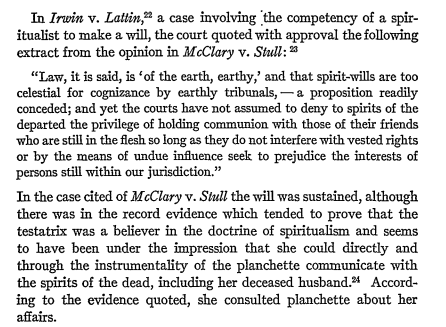
2. Gerald Mayo v. Satan and His Staff (1971)
Have you ever been so down on your luck that you thought it must be the work of the Devil? Well, good luck trying to sue Satan. Gerald Mayo attempted to do so in 1971—an inmate at Western Penitentiary in Pittsburgh, Pennsylvania, Mayo filed a claim with the United States District Court for the Western District of Pennsylvania, which stated, “Satan has on numerous occasions caused plaintiff misery and unwarranted threats, against the will of plaintiff, that Satan has placed deliberate obstacles in his path and caused the plaintiff’s downfall.”[2]Charles Yablon, Suing the Devil: A Guide for Practitioners, 86 VA. L. REV. 103 (February 2000). This article can be found in HeinOnline’s Law Journal Library.
Unfortunately for Mayo, the court ruled that the Devil is not an American, but rather “a foreign prince with no standing to sue in an American Court.”[3]Charles Yablon, Suing the Devil: A Guide for Practitioners, 86 VA. L. REV. 103 (February 2000). This article can be found in HeinOnline’s Law Journal Library. The case would potentially have been better suited as a class action, but the Court stated that they couldn’t “determine if the representative party will fairly protect the interests of the class.” [4]Charles Yablon, Suing the Devil: A Guide for Practitioners, 86 VA. L. REV. 103 (February 2000). This article can be found in HeinOnline’s Law Journal Library. Additionally, the Devil does not have an address (that Mayo knew of) and therefore the Court could not serve him the proper papers.[5]Joseph L. Albini, The Mafia and the Devil: What They Have in Common, 9 J. CONTEMP. CRIM. JUST. 240 (August 1993). This article can be found in HeinOnline’s Law Journal Library. The case was moot, and Mayo was left to contend with the Devil by himself.
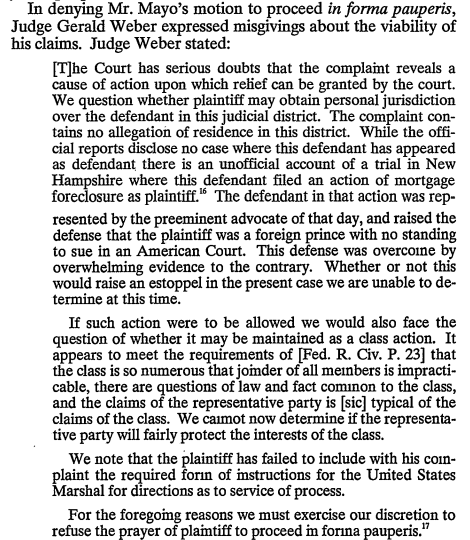
3. Stambovsky v. Ackley (1991)
Buying a home is stressful enough—imagine finding out your new dwelling is full of ghosts. That’s just what happened to Jeffrey Stambovsky when he purchased a home from Helen Ackley in Nyack, New York. Ackley had for many years purported that her home was haunted; in fact, she even reported on the spirits[6]Mark Giancaspro, Testing the Boundaries of the Consideration Doctrine: Can You Contract to Buy and Sell a Ghost?, 45 ALTERNATIVE L.J. 107 (June 2020). This article can be found in HeinOnline’s Law Journal Library. roaming her home in both Readers’ Digest and a local newspaper, but Stambovsky was not informed of the home’s otherworldly nature. So, Stambovsky put down his down payment. After learning about the spooky reputation of the home, he wanted to rescind the sale.
The New York Supreme Court dismissed the initial case, and Stambovsky appealed. The appellate court famously ruled that, “as a matter of law, the house is haunted.” The Court also put forth a statement worthy of its own horror novel:[7]Paula C. Murray, AIDS, Ghosts, Murder: Must Real Estate Brokers and Sellers Disclose, 27 WAKE FOREST L. REV. 689 (1992). This article can be found in HeinOnline’s Law Journal Library. “While I agree with [the] Supreme Court that the real estate broker, as agent for the seller, is under no duty to disclose to a potential buyer the phantasmal reputation of the premises, and that, in his pursuit of a legal remedy for fraudulent misrepresentation against the seller, plaintiff hasn’t a ghost of a chance, I am nevertheless moved by the spirit of equity to allow the buyer to see rescission of the contract of sale and recovery of his down payment.” This case became known as the Ghostbusters ruling, and we have a dedicated blog post all about it.
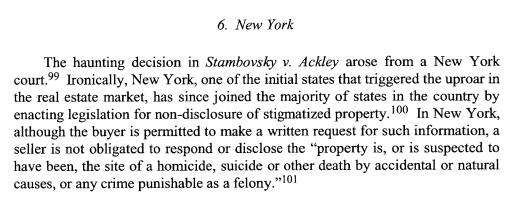
4. Ferlito v. Johnson & Johnson (1992)
What could be worse than lighting yourself on fire? Lighting yourself on fire while dressed as a sheep. One plaintiff found this out the hard way. Susan and Frank Ferlito attended a Halloween party dressed as Little Bo Peep and her sheep. For his costume, Frank Ferlito was covered head to toe in Johnson & Johnson cotton batting.[8]Daniel B. Moar, Case Law from the Crypt: The Law of Halloween, 83 N.Y. ST. B.A. J. 10 (October 2011). This article can be found in HeinOnline’s Bar Journals Library. Unfortunately, Frank was not aware that cotton batting is highly flammable—while attempting to light a cigarette, his costume caught on fire and he suffered extensive burns.
The Ferlitos sued Johnson & Johnson in a personal injury suit, claiming that they didn’t provide enough warning about the flammability of their cotton batting product. However, the case was dismissed when the Court determined that, essentially, it was a matter of common sense. Cotton “is a simple product with all of its essential characteristics apparent, including flammability.”[9]John G. Browning, Creepy Cases: Halloween Often Comes with Something Really Scary – A Lawsuit, 77 TEX. B.J. 772 (October 2014). This article can be found in HeinOnline’s Bar Journals Library.
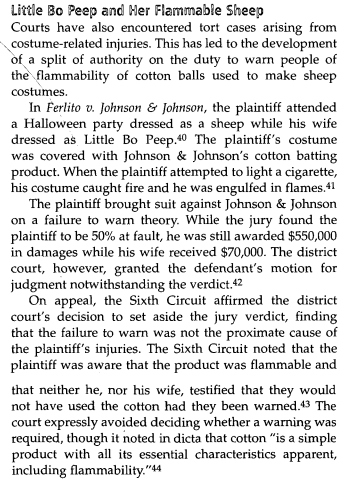
5. Horror Inc. v. Miller (2021)
For fans of the movie Friday the 13th, this case is especially terrifying. Manny Company assigned Victor Miller, a Writers Guild of America member, to write the movie’s screenplay in 1979. Miller and Manny Company signed a Writer’s Flat Deal Contract[10]Tim Kelly, Jason’s Long Night at Camp Blood: Surveying the Independent Copyrightability of Jason Voorhees in the Wake of Horror Inc. v. Miller, 10 CYBARIS INTELL. PROP. L. REV. 41 (2019). This article can be found in HeinOnline’s … Continue reading for the work. Horror Inc., Manny’s successor, then took on the rights to the entire Friday the 13th franchise, including the screenplay.
However, in 2016, Miller issued a notice to terminate the 1979 grant of his screenplay’s copyright to Horror Inc. Horror Inc. and Manny Company claimed that this termination was invalid because Miller had written the screenplay as a work for hire,[11]Alexa Browning, The Horrors of Copyright Law: An Analysis of Character Copyright Issues & Iconic Horror Villains, 13 NYU J. INTELL. PROP. & ENT. L. 163 (Fall 2023). This article can be found in … Continue reading which, under the Copyright Act, means that the worker is an employee and therefore releases copyright ownership to their employer. Miller, on the contrary, argued that he was hired as an independent contractor, not an employee, and therefore he retained the ownership of the screenplay’s copyright. A district court sided with Miller—hence, why there hasn’t been a new Friday the 13th movie in over a decade. However, the court did not issue a definitive opinion as to whether copyright of the character Jason Voorhees[12]Tim Kelly, Jason’s Long Night at Camp Blood: Surveying the Independent Copyrightability of Jason Voorhees in the Wake of Horror Inc. v. Miller, 10 CYBARIS INTELL. PROP. L. REV. 41 (2019). This article can be found in … Continue reading belongs to Miller or to Horror, Inc.
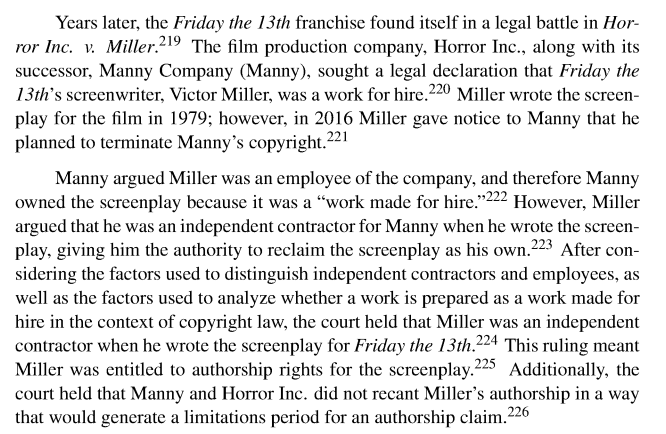
Explore More…If You Dare
Our Law Journal Library and Bar Journals Library are excellent places to learn more about the background of different court cases. Take a look and see what you can dig up. However, HeinOnline cannot be held responsible for any horrors that you might unearth!
HeinOnline Sources[+]
| ↑1 | Blewett Lee, Psychic Phenomena and the Law, 34 HARV. L. REV. 625 (1920-1921). This article can be found in HeinOnline’s Law Journal Library. |
|---|---|
| ↑2, ↑3, ↑4 | Charles Yablon, Suing the Devil: A Guide for Practitioners, 86 VA. L. REV. 103 (February 2000). This article can be found in HeinOnline’s Law Journal Library. |
| ↑5 | Joseph L. Albini, The Mafia and the Devil: What They Have in Common, 9 J. CONTEMP. CRIM. JUST. 240 (August 1993). This article can be found in HeinOnline’s Law Journal Library. |
| ↑6 | Mark Giancaspro, Testing the Boundaries of the Consideration Doctrine: Can You Contract to Buy and Sell a Ghost?, 45 ALTERNATIVE L.J. 107 (June 2020). This article can be found in HeinOnline’s Law Journal Library. |
| ↑7 | Paula C. Murray, AIDS, Ghosts, Murder: Must Real Estate Brokers and Sellers Disclose, 27 WAKE FOREST L. REV. 689 (1992). This article can be found in HeinOnline’s Law Journal Library. |
| ↑8 | Daniel B. Moar, Case Law from the Crypt: The Law of Halloween, 83 N.Y. ST. B.A. J. 10 (October 2011). This article can be found in HeinOnline’s Bar Journals Library. |
| ↑9 | John G. Browning, Creepy Cases: Halloween Often Comes with Something Really Scary – A Lawsuit, 77 TEX. B.J. 772 (October 2014). This article can be found in HeinOnline’s Bar Journals Library. |
| ↑10 | Tim Kelly, Jason’s Long Night at Camp Blood: Surveying the Independent Copyrightability of Jason Voorhees in the Wake of Horror Inc. v. Miller, 10 CYBARIS INTELL. PROP. L. REV. 41 (2019). This article can be found in HeinOnline’s Law Journal Library. |
| ↑11 | Alexa Browning, The Horrors of Copyright Law: An Analysis of Character Copyright Issues & Iconic Horror Villains, 13 NYU J. INTELL. PROP. & ENT. L. 163 (Fall 2023). This article can be found in HeinOnline’s Law Journal Library. |
| ↑12 | Tim Kelly, Jason’s Long Night at Camp Blood: Surveying the Independent Copyrightability of Jason Voorhees in the Wake of Horror Inc. v. Miller, 10 CYBARIS INTELL. PROP. L. REV. 41 (2019). This article can be found in HeinOnline’s Law Journal Library. |



